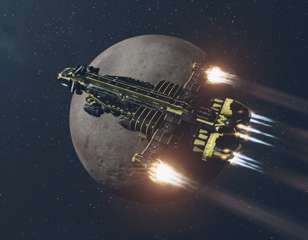Starfield review: An imperfect interstellar odyssey
To some, Starfield may feel like more of the same in space. To others, that’ll be exactly what they’re looking for. When you give it time to breathe, the game shows you its strengths and invites you to play the way you wish. Not all of its features work out but most do, and the control you have over your journey makes it an excellent trip all the same.
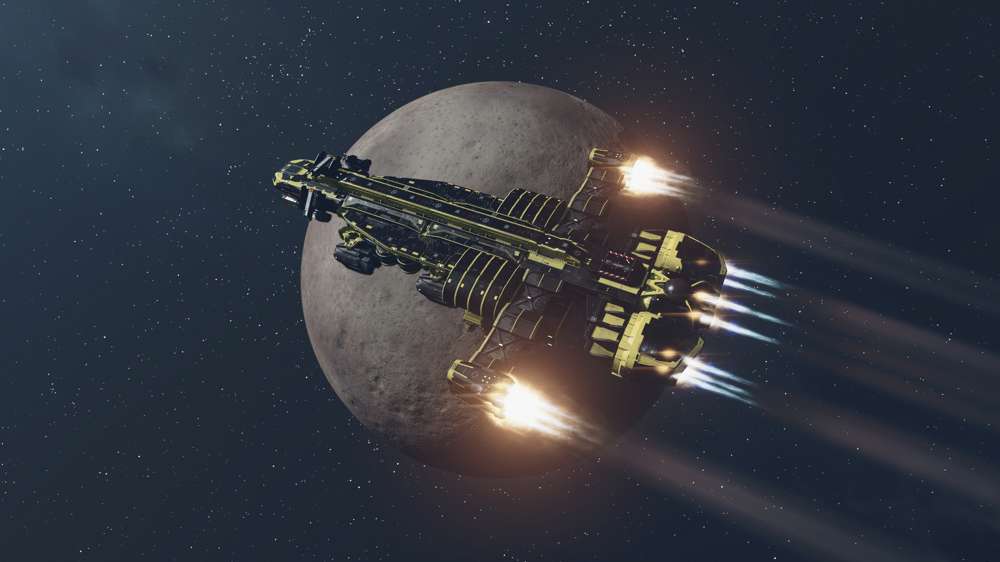
To some, Starfield may feel like more of the same in space. To others, that’ll be exactly what they’re looking for. When you give it time to breathe, the game shows you its strengths and invites you to play the way you wish. Not all of its features work out but most do, and the control you have over your journey makes it an excellent trip all the same.
Images via Bethesda
Platform(s)
Xbox Series X/S, PC
Released
06/09/2023
Developer
Bethesda Game Studios
Genre
Action RPG
Publisher
Bethesda Softworks
Engine
Creation Engine 2
Multiplayer
No
ESRB
Mature 17+. Blood, Strong Language, Suggestive Themes, Use of Drugs, Violence
Starfield’s scope seemed almost too good to be true. Its promise of a thousand planets and near-endless exploration pulled players in, conjuring images of an awe-inspiring adventure few games could ever dream of achieving.
Realistically, quality exploration is nearly impossible to maintain when it’s spread so thin across so many areas. Early in the main quest, you’re tasked with travelling to Mars to speak to someone at a bar. You land your ship there, walk into an underground city, visit the bar, and one conversation later you’re told you need to go to Venus.
There’s no time to drink in any of the details on this new planet if you want to follow the story - it just whisks you away to another place millions of miles away. And when you’re done clearing the Venus shipyard, you’re already on your way to Neptune.
Rather than immersing you in its immense environments, Starfield wants to move you onto the next thing, like an impatient kid at a museum. Your adventure is constantly broken up by clunky fast travel and loading screens. But the beauty of open-world games is that you don’t have to play by the rules. You can spend as much time as you want exploring the universe at your own pace and building your character the way you see fit. This is where Starfield shines.
GGRecon Verdict
To some, Starfield may feel like more of the same in space. To others, that’ll be exactly what they’re looking for. When you give it time to breathe, the game shows you its strengths and invites you to play the way you wish. Not all of its features work out but most do, and the control you have over your journey makes it an excellent trip all the same.
Into the Void
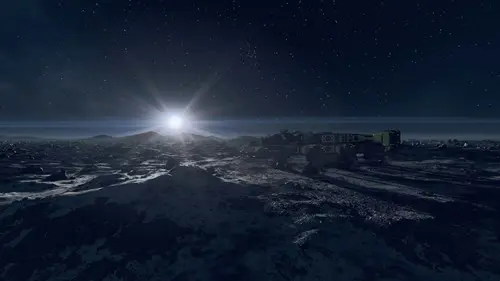
If you treat the game like a whistle-stop tour of every planet in a system, you’ll be quickly exhausted by the sheer amount of them (and how much fiddling around with map menus you’ll be forced to do). When you allow yourself to forge your own path and absorb each discovery along the way, Starfield morphs into a much more engaging interstellar journey.
By soaking in the details of a distant moon or the residents of a small colony, you’ll find yourself appreciating how much effort was put into seemingly minor discoveries. There are lots of lore tidbits to find for players who really enjoy learning about each world, and side quests help the universe come alive. Whether it’s picking up special sauce for an enthusiastic restaurant worker or helping the families of a small settlement band together against invaders, these moments lend a sense of humanity to the gargantuan void stretching across the Settled Systems.
You could play for hundreds of hours and still be far from seeing everything in the universe, and that’s exactly what some players desire in a huge open-world RPG. For others the sheer size will veer into oppressive territory, damaging the pacing that could have emerged from a smaller series of more intimate worlds. One thousand planets is simply too many; procedurally generated content can’t compete with curated spaces, and many of these worlds are uninviting and barely distinct.
That’s not to say Starfield isn’t worth exploring though. Touching down on a new planet treats you to beautiful vistas, and landmarks immediately draw the eye. It’s visually stylish, and I’m constantly tempted to enter into photo mode and snap whatever sights I’m currently seeing.
Interiors are intricately furnished, and it’s clear a lot of love went into designing all the decorations and details dotted about. The artists did an exceptional job making places feel lived-in, with great care given to the designs of each object in the game. It’s amazing to see how much detail was put into a universe so immense.
Life on the Frontier
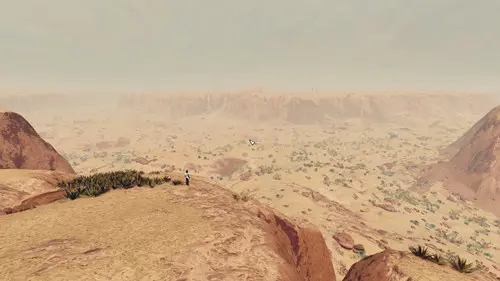
It’s easy to appreciate the design of Starfield when you’re not rushing to new planets constantly. Setting out into the frontier can be quite a relaxing experience. There’s a certain tranquillity in scanning fauna and flora as you explore, the sounds of ships landing in the distance as you stray further from your own.
Stumbling into settlements can lead to miscellaneous quests, or you might find dangerous creatures in the wild to take down. I met a wounded colonist trapped in a cave and healed her with one of my med packs. She told me she needed to get back to her outpost, so off we went. Only our journey was interrupted by a vicious alien, and the colonist was quickly ripped apart. I teamed up with a gang of nearby religious fanatics to take it down - who then turned on me as soon as the creature fell.
These unscripted moments can make exploration a lot of fun. Traversal takes a lot of time though, and eventually feels pointless when you look out and see nothing but rocks for miles. Gaming’s incessant desire to burden us with stamina meters is tiresome. Procedurally generated structures and activities are usually weaker than the average handcrafted quests too.
The variety of weird alien designs is reminiscent of No Man’s Sky, but here they’re less cobbled together and more intentional. I would’ve loved to be able to see everything I’ve scanned in some kind of encyclopedia - surveying planets can get quite addicting despite the repetition. Its main purpose is to gather survey data which you can sell. This can be a slow process, but it’s nice that Starfield lets you make money solely from exploring if you’re less inclined to constant combat.
Immersion can sometimes take a hit when it comes to dialogue and characters. In Cydonia on Mars, I strolled right past the guards into the Governor’s office, struck up a conversation, offered him a bribe, got rejected, and then left like nothing happened. On another occasion, I boarded a shady vessel and a random guard immediately told me everything I could possibly need to know about the valuable loot on board. Starfield isn’t too concerned with creating believable scenarios, but in a way, that’s part of the fun. You never know what ridiculous situation you might encounter next.
A fresh take on a familiar formula
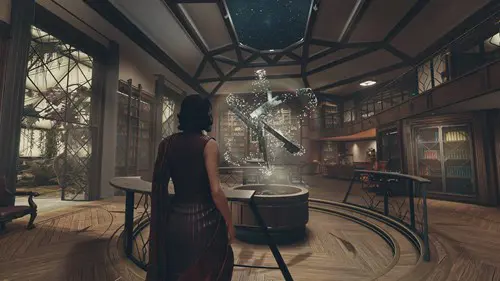
This is still a Bethesda game, and it’s clear the team didn’t want to shy away from what made their previous games so successful. If you like Fallout and Elder Scrolls, you’ll probably like Starfield. It’s not the genre-defining innovator some hoped it would be; instead, it takes tried-and-tested concepts and expands on them to make the most feature-rich Bethesda RPG yet.
Surprisingly, Starfield is more polished than a lot of big-budget games tend to be. We’ve grown so accustomed to jank that a working product feels innovative, but despite Starfield’s size, it’s not the technical disaster some expected it to be. NPCs can be glitchy and they’ll constantly talk over each other when you walk near them, but I haven’t run into any game breaking bugs while playing. An NPC did disappear mid-conversation once though. That’s just classic Bethesda.
Combat is classic Bethesda too, with a touch of interstellar flair. Firing kinetic weapons in low-gravity areas might propel you backwards, and boost packs add mobility. Outside of that the variety isn’t too dissimilar to Fallout. You’ve got laser guns, shotguns, frag grenades and mines, all the standard stuff you’d expect to see in the wasteland - despite Starfield taking place in the distant future.
It’s fun enough, and so is the ship combat. Lasers take down shields while missiles shred through hulls, but once you’ve been in one ship battle you’ve pretty much seen them all. Space travel is the lowest point of Starfield - it feels like an afterthought or an early concept they never quite nailed. Sure, you can spend hours flying from planet to planet - but unless you want to waste your life, space exists for you to very briefly visit before docking at a station or fast travelling to the surface.
It soon becomes apparent that it’s merely a backdrop for ship fights and not much else. It doesn’t feel like you’re discovering planets yourself or stumbling into strange things. It’s one step up from a loading screen, and that’s a big missed opportunity. We could have done with a few less barren moons and a few more interesting events to discover in the infinite void.
Creation among the Cosmos
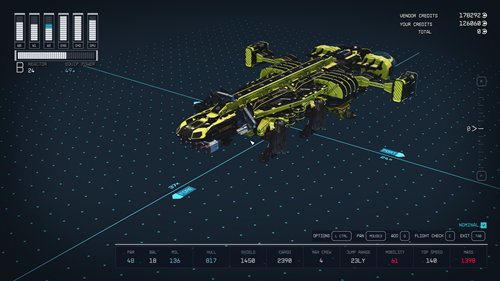
Starfield is Bethesda’s most customisable RPG yet. Character creation is more in-depth, and you can create your own ship too. It feels like a home away from home. Ship customisation is satisfying and adds a personal touch to your adventure, and allows for all kinds of new inventions or wacky re-creations of things from other franchises. Some of my favourite moments in Starfield have been refurbishing my ship and admiring my work from afar.
Outposts are more optional. If you really want, you can turn the universe into an industry and churn out resources through inter-system cargo links. Planet surfaces turn into blank slates for you to shape and scour for minerals. There’s so much open space to claim as your own, and the Outposts you can build there feel more purposeful than Fallout 4’s settlements. You’re free to use this feature as much as you like, whether you’re just dabbling in it or creating huge networks to farm resources.
These Outposts don’t offer much in the way of creativity though. They exist as a way to get materials, but they’re not much fun to customise. As far as living spaces go you’re limited to bland habitats, with no real building blocks to toy with. You can decorate the interior, but the exterior options are poor. In comparison, shipbuilding is a fantastic avenue for creativity.
The lack of instructions might leave you baffled by the confusing way Outposts actually work. It’s far less hassle to just buy materials you need from vendors all over the game’s cities. Delving into Outposts requires a big skill point commitment, and unless you’re the kind of person this system appeals to, you’re unlikely to spend much time with it after all that levelling up.
The huge range of skills on offer is daunting at first. I actually came to appreciate how it made me think about my choices while levelling up - prioritising one thing before another might lead you down a different gameplay path for a while. It’s possible to get everything eventually, but shaping your character through your skills is engaging.
Roleplaying isn’t as fleshed out here as recent competition like Baldur’s Gate 3, but it’s a lot better than the days of Fallout 4’s forced parenthood. I picked a Xenobiologist role for my character, so I’ve picked up a lot of Science skills for her over time. I can make credits from surveying a planet’s fauna and flora and then selling the data. You can play into your character’s background if you like, whether you’re a scientist, soldier or a ruthless pirate. Just don’t pick the chef - food is practically worthless in Starfield.
Faction Attractions
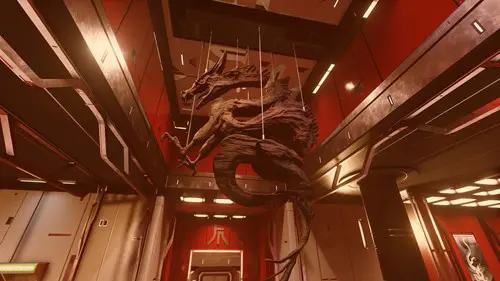
When it comes to the game's factions, you’re pretty much destined to become a jack of all trades and a master of all too. You can complete every faction questline in a single playthrough even when those factions seem like they’d be utterly opposed to the idea of you joining anyone else. This isn’t a new thing in Bethesda games, but even Skyrim made you choose between Stormcloaks and Imperials.
Ryujin Industries makes sense as your first faction, as joining a low-level corporate role after you’ve battled your way through the other questlines is a little ridiculous. Its quests are pretty mediocre, ranging from easy fetch quests to frustrating stealth missions, though the narrative and themes manage to land. Its main strength is the city where most of it takes place - Neon is an eclectic blend of futuristic fisheries, lavish lounges and depressing slums, all bathed in a cyberpunk glow.
The UC Vanguard immediately grips you with its spooky first mission, and from there, it continues to be one of the game’s better questlines. The Freestar Rangers and the Crimson Fleet are also solid additions to the game with some meatier quests to get stuck into. These quests offer confined storylines you can dabble in whenever you want, but they’re not going to introduce many hugely significant changes to the game world or overall experience.
The main story is the most developed, and as you might expect it’s the longest with the most characters. As such, it’s difficult to care about many of them at first. When you’re introduced to Constellation and tasked with scouring the universe for artifacts it feels like little more than a fetch quest. Soon that fetch quest results in some real consequences though, and things start to pick up.
I won’t spoil too much, but you’re not the only one in the universe who cares about these artefacts. The further you get, the more resistance you’ll face. The reveal of this opposing force is foreboding and sets the stage for a higher-stakes storyline. They feel like less of a threat at first when you can whip out a minigun and rinse them, but don’t get complacent. Starfield has a turning point with huge ramifications for the story, and it injects the game with a vital dose of drama.
This is all to say that Starfield’s quests are a solid bunch of independent storylines. They’ll keep you occupied for a long time, adding tons of content to an already huge game. If you’re not as keen on exploring, you can focus on these quests and still have a good time. If you’re more like me, you’ll neglect the questlines to spend hours scanning wildlife, building outposts or tackling side missions before eventually returning to mop them all up. Each playstyle is valid, and the game scales with your character to a certain extent so you don’t feel completely overpowered.
The Verdict
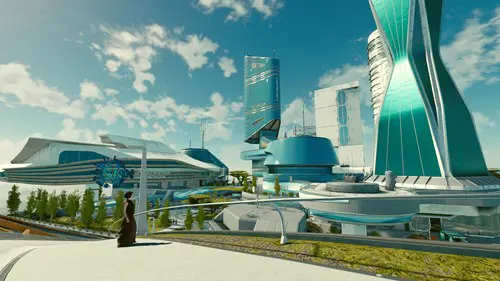
Starfield’s ambition betrays it somewhat, and its contemporaries have excelled at certain things it falls short of, making it seem half-baked at first. But the more I played Starfield, the more I fell in love with it. Frustrations about poor space travel and menu navigation faded away as I got used to it, and the more discoveries I made the more I appreciated what Bethesda have created here. There’s still too much fast travel, and those discoveries needed to be more authentic, but it became the perfect comfort game for me. An ideal chill-out adventure just like Skyrim or Fallout before it.
It doesn’t demand you make life-or-death decisions constantly, and it lets you goof around as much as you want. There’s a thoughtful story in there somewhere, but this is not a game you play to rush the main quests - despite what some people might be claiming. Take your time to find which of the game’s systems appeals to you most and you’ll find a game that moulds itself to your personal tastes.
If you’re the creative type you can focus on finding ships and repurposing them into your own designs. Or become a pirate and turn the universe into a back street ripe for theft and murder. If exploring is your thing, you can get lost in Starfield’s near-infinite worlds and systems.
To some, Starfield may feel like more of the same in space. To others, that’ll be exactly what they’re looking for. When you give it time to breathe, the game shows you its strengths and invites you to play the way you wish. Not all of its features work out but most do, and the control you have over your journey makes it an excellent trip all the same.
4/5
Reviewed on PC. Review code provided by the publisher.
Comments

